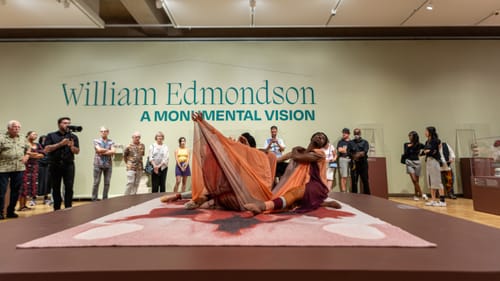Stay in the Loop
BSR publishes on a weekly schedule, with an email newsletter every Wednesday and Thursday morning. There’s no paywall, and subscribing is always free.
Still a fascinating figure
The Barnes Foundation presents William Edmondson: A Monumental Vision

The day I initially visited the Barnes Foundation to see William Edmondson: A Monumental Vision was the same day as Philly’s Code Red air advisory. Across the city, the haze from the southbound smoke of Canadian wildfires cast a warm rosy filter, an eerily apocalyptic yet aesthetically pleasing affect. I was in the minority of people I saw who opted to mask outdoors.
Within this context, walking into the exhibit was literally a breath of fresh air. The hosting Roberts Gallery was brightly lit and spaciously laid out, and the color palette of dusty pinks, burgundies, and greens against Edmondson’s limestone figures evoked a garden or yard similar to his own where his pieces were originally displayed in Nashville, Tennessee.
A spiritual undercurrent
Born on a plantation to formerly enslaved parents in 1874, Edmondson spent most of his life working with his hands: as a sharecropper in his youth, a railroad-shop employee until his early 30s, and a custodian at a women’s hospital for nearly 25 years. Once the hospital closed and he was entering his 60s, he first taught himself to carve tombstones following a vision from God, who instructed him to do so. His reputation and reach grew as he started selling these tombstones, engraved in his signature block lettering, as well as lawn ornaments and other sculptures, to his neighbors and the surrounding Black community.
Being from the Black Southern Baptist tradition, Edmondson’s religion is a central motif in his art. Some of the references (a pulpit, bible, crucifix, and preacher) are more literal than others. Even some of his depictions of animals (a dove, ram, or lion, for example) are speculatively biblical in nature. Because a lot of his work is also funerary in origin, the practices of altar-building and ancestor veneration, originating in West Africa, are recalled. Ironically, the exact location of Edmondson’s own final resting place has been lost following a fire that burned the records of Nashville’s oldest Black cemetery. Yet, his spirit remains ever-present in the space via photographs of him and what he tactically produced through his energy and imagination. This undercurrent of spirituality imbues the gallery with an elevated sense of hallowedness.
Edmondson’s women
He never married, but he spent a lot of time around women, whether family members or those he worked with or encountered as patients at the hospital, and his work shows great interest in female figures. While most of these women remain anonymous, a few sculptures hint at his personal reverence and relationships. Attention and detail, however, are given equally to all of their fashions, postures, and hair. Miss Louisa, who may have been a love interest of Edmondson’s, is shown holding a hat, her dress cinched at the waist with a bow in the back and pleats in her skirt.
One of my favorite pieces is of a bride holding a bouquet and wearing a textured wedding dress with a train and long, billowing veil. With this piece, Edmondson achieves a level of delicateness and movement that transcends the heaviness of the stone. On display are also two sculptures of Eleanor Roosevelt, an important political figure of his time that he may have admired for being socially progressive. There are even a handful of female nudes, but the most notable nude, Reclining Man, depicts one of his few male subjects.
The institutional gaze
In 1937, Edmondson became the first Black artist to have a solo exhibit at the Museum of Modern Art in New York. What should have been a celebration of his art and accomplishments was overshadowed by the colonial, institutional gaze that labeled his work “primitive modern” and stereotyped his Southern identity, undermining his personal agency and individuality. At the same time, this created new opportunities and avenues for him to connect to collectors and customers. Because there was a lack of curiosity about his inner world and what complexities lay within, missing are his own first-person accounts of how he felt about his public portrayal and rise to notoriety.

Returning to Before
Recognizing the roles that arts and cultural institutions have historically played in harming artists from marginalized backgrounds or communities of color, the Barnes has been conscientious in its treatment of Edmondson’s perspective and image. This includes Returning to Before, an immersive dance performance that premiered on Friday, July 14, with an accompanying artist talk moderated by James Claiborne, Barnes curator of public programs and co-curator of Monumental Vision, featuring Brendan Fernandes, the Kenyan Canadian multi-disciplinary artist behind Returning to Before, and Christina Knight, assistant professor of visual studies at Haverford College.
Fernandes, who also created a textile piece that anchors the performance, created Returning to Before to honor Edmondson’s spiritual and physical practices, and also to encourage museum visitors to reimagine their role in the space. The dancers’ oversized mesh, multicolored costumes (reminiscent of choir robes) and their movements en pointe forming sculptural postures reminded me of Alvin Ailey’s signature Revelations piece. Return to Before will be performed on Saturdays at noon and 2pm through September 2.
While I was entranced and even emotionally moved by the piece, it still highlighted for me all the ways we as the consumers of art are not allowed to be embodied in museum spaces—we are not allowed to touch the artwork and often must keep an arbitrary distance; we are discouraged from conversing or any loud expressive reactions; and unlike the dancers, we cannot stand on platforms, dance, or run even as the art is meant to elicit these visceral reactions.

Room for a reparative process?
This is perhaps why Edmondson remains such a fascinating figure in the art world. He personified and blurred so many of the lines between what we are told you are not “supposed” to be in order to be taken seriously as an artist or within art spaces, including being an elder, self-taught, southern, Black, and Christian. An unimaginative or ignorant eye would not be able to see limestone in its raw form, or Edmondson himself, and visualize the potential to become so much more once you chip away the layers. But he knew himself and was the one given the vision.
I can’t help but to think what it would have meant for his work to primarily remain in possession of the Black Nashvillians he originally created it for. He intended his work for the honoring, enrichment, and memory of their lives, not the art institutions and wealthy private collections (artist KAWS loaned the Barnes several pieces he owns) where Edmondson pieces are now almost exclusively held for profit and enjoyment. And even in the self-awareness of some of this, any institutional intervention that does not go a step further to explicitly consider or contend with some restorative or reparative process seems somewhat shortsighted.
What, When, Where
William Edmondson: A Monumental Vision. Through September 10, 2023, at the Barnes Foundation, 2025 Benjamin Franklin Parkway, Philadelphia. $5-$25 (admission valid for two days). (215) 278-7000 or barnesfoundation.org.
Performances of Returning to Before take place in the gallery at 12pm and 2pm on Saturdays through September 2, 2023.
Accessibility
The Barnes is a wheelchair-accessible venue.
Sign up for our newsletter
All of the week's new articles, all in one place. Sign up for the free weekly BSR newsletters, and don't miss a conversation.

 Hanae Mason
Hanae Mason